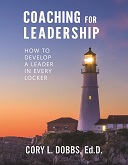“Who am I to…”
Why Student-Athletes Don’t Lead
Dr. Cory Dobbs
One of the deepest needs within people is belonging. If you’re a coach you belong to the coaching “fraternity” or “sorority.” And it feels good to belong. These are your people, your friends, colleagues and confidants. They think much like you do which makes it easy to be around one another. There are coaching and administrator associations that hold annual events that you love to attend to be around others just like you. Belonging is natural.
Your student-athletes—team captains or team leaders—want to belong too. They seek an inner congruence for order, harmony, and peace with their teammates. They too want the team to be like a fraternity or sorority. They want to belong. So when it comes time to lead, the typical team captain or team leader is afraid to do something that seems incongruent with their values and beliefs. Their first thought is “Who am I to tell her she needs to stop doing that.” They feel a real mental conflict.
Dr. Leon Festinger, a researcher and professor at Stanford University, coined the term “cognitive dissonance” to explain this mental conflict that the team leader feels. Cognitive means the mind, the way we think. Dissonance means conflict. Cognitive dissonance literally means to have a mental conflict.
According to Festinger, and subsequently many other researchers, when an individual experiences cognitive dissonance they quickly search for a way to reduce the incongruence causing the dissonance.
The person with the conflict is motivated to reduce the inner turmoil in some manner. For example, the thirty-five year old factory worker who smokes a pack a day on his breaks knows (doesn’t everyone?) that smoking is bad for you. So to reduce the psychological tension he adopts the position, “My aunt lived to one-hundred and she smoked a pack a day so it must not be that bad for you.” This cognitive maneuver reduces the internal tension caused by his actions—smoking—and his knowledge of facts—smoking is bad for you but it can’t be that bad if my aunt could smoke and live to one hundred.
Why is it that student-athletes fear leadership roles and responsibilities? Simply put, when a student-athlete is asked to perform a peer-to-peer leadership action, it is, by default, inconsistent with his or her existing values, beliefs, and perceived skills. This causes a conflict—dissonance—that inhibits the likelihood of the peer leader taking action. The internal dialogue of “Who am I to do this” will generally rule the day.
How then can you change the outcome of inaction? Practice, practice, practice. Just as you practice your offensive and defensive systems, you must practice your leadership system. To change internal beliefs is a challenge, it takes time and commitment. Is it complicated? Yes, of course! But if you don’t make a deliberate effort to address the issue of cognitive dissonance, your team is vulnerable to the costs that come with the lack of team leadership. «

To find out more about and order Sport Leadership Books authored by Dr. Dobbs including a Leader in Every Locker that this post was taken from, Click this link: The Academy for Sport Leadership Books
This article was written by Cory Dobbs, Ed.D., President of The Academy for Sport Leadership. The Academy for Sport Leadership is a leading educational leadership training firm that uses sound educational principles, research, and learning theories to create leadership resources. The academy has developed a coherent leadership development framework and programs covering the cognitive, psycho-motor, emotional and social dimensions of learning, thus addressing the dimensions necessary for healthy development and growth of student-athletes.
About the Author
Cory Dobbs is the founder and president of The Academy for Sport Leadership, a national leader in research‐based curriculum for coaches and student‐athletes. Dr. Dobbs is a college educator, a coach to successful coaches (helping coaches attain a higher level of success), and an accomplished human performance specialist whose expertise is in the field of leadership, team building, and creating a high‐performance culture in the arena of team sports. Cory blends social‐personality, psychology, and applied social psychology, which means he studies how people’s thoughts, behaviors, and preferences are influenced by both who they are and the situations they’re in. He uses Teamwork IntelligenceTM to help teams explore how the mix of perspectives brought by their individual members influences their work together.
About The Academy for Sport Leadership
The Academy for Sport Leadership is a leading educational leadership training firm that uses sound educational principles, research, and learning theories to create leadership resources. The academy has developed a coherent leadership development framework and programs covering the cognitive, psycho-motor, emotional and social dimensions of learning, thus addressing the dimensions necessary for healthy development and growth of student-athletes.
The Academy for Sport Leadership’s underlying convictions are as follows: 1) the most important lessons of leadership are learned in real-life situations, 2) team leaders develop best through active practice, structured reflection, and feedback, 3) learning to lead is an on-going process in which guidance from a mentor coach helps facilitate learning and growth, and 4) leadership lessons learned in sport should transcend the game and assist student-athletes in developing the capacity to lead in today’s changing environment.


